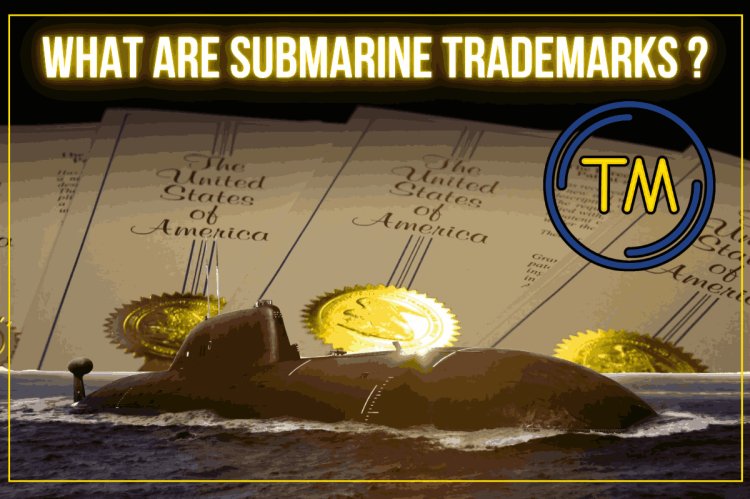What are submarine Trademarks?
In the realm of intellectual property law, submarine trademarks emerge as strategic assets, concealed beneath the surface of traditional trademark registration. Unlike their conventional counterparts, submarine trademarks undergo deliberate delays in registration, allowing owners to maintain secrecy and strategic advantage. This article explores the intricacies of submarine trademarks, their anatomy, strategic considerations, and implications within the framework of trademark law.

Exploring Submarine Trademarks:
In the vast ocean of intellectual property law, trademarks stand as beacons guiding consumers to recognize and trust certain brands. However, beneath the surface lies a lesser-known phenomenon: submarine trademarks. These clandestine assets lurk beneath the waves of trademark registries, strategically positioned to surface at opportune moments. But what exactly are submarine trademarks, and how do they navigate the murky waters of intellectual property?
Understanding Submarine Trademarks:
Submarine trademarks, also known as phantom trademarks or sleeper trademarks, operate within the realm of intellectual property law, specifically in the domain of trademarks. Unlike conventional trademarks, which are promptly registered and visible to the public eye, submarine trademarks are intentionally delayed in their registration process, remaining hidden from competitors and consumers alike. The strategy behind submarine trademarks revolves around timing. By deferring registration until a later date, trademark owners can conceal their intentions and strategic plans from competitors while maintaining priority rights to their mark. This clandestine approach allows them to carefully observe market trends, assess consumer behavior, and fine-tune their branding strategy before officially surfacing their trademark.
The Anatomy of a Submarine Trademark:
At the core of a submarine trademark lies a meticulously crafted brand identity, awaiting its moment to emerge. Trademark owners meticulously develop their logos, slogans, or other distinctive identifiers, ensuring they resonate with their target audience and differentiate their products or services from competitors.
Once the trademark is ready for deployment, trademark owners file an intent-to-use application with the relevant trademark office, signaling their intent to use the mark in commerce. However, instead of swiftly progressing through the registration process, these applications remain dormant, concealed from public view until the trademark owner decides to activate them.
Strategic Considerations:
The decision to deploy a submarine trademark is not taken lightly. Trademark owners must weigh the benefits of secrecy and strategic advantage against the risks of potential challenges and legal complexities. Timing is critical, as premature activation of the trademark could undermine its effectiveness, while delayed deployment may result in missed opportunities. Trademark owners must conduct thorough research and analysis to ensure their submarine trademarks do not infringe upon existing trademarks or run afoul of intellectual property laws. Diligent monitoring of market trends and competitor activity is essential to gauge the optimal moment to surface the trademark and capitalize on brand recognition.
The rationale behind the use of submarine trademarks varies, but it often revolves around strategic considerations and competitive advantage. By keeping a trademark application pending for an extended period, applicants can maintain secrecy regarding their intended branding or product offerings, preventing competitors from gaining insights into their future plans. This clandestine approach allows applicants to quietly build brand equity and market presence before officially unveiling their trademarks to the public. The strategy behind submarine trademarks is multifaceted, often driven by a desire to secure future market opportunities, deter potential competitors, or engage in brand speculation. By filing trademarks preemptively, businesses can stake their claim to brand names, slogans, or logos without immediately launching products or services under those marks. This preemptive filing strategy allows businesses to maintain flexibility, protect their intellectual property, and potentially block competitors from using similar marks in the future.
Implications for Trademark Law:
The use of submarine trademarks poses unique challenges and considerations within the realm of trademark law. While trademark offices strive to promote transparency and efficiency in the registration process, submarine trademarks introduce an element of ambiguity and uncertainty. Competitors may find it difficult to assess the landscape of existing trademarks and make informed decisions regarding branding and market positioning in the absence of full visibility into pending applications.
Navigating Legal and Ethical Considerations:
From a legal and ethical standpoint, the use of submarine trademarks raises questions regarding fairness, transparency, and the integrity of the trademark registration system. Critics argue that deliberately delaying trademark applications undermines the principles of openness and accountability, potentially leading to conflicts and disputes down the line. Trademark owners must navigate the intricate timelines and requirements stipulated by trademark offices to ensure their submarine trademarks remain afloat. Failure to meet deadlines or demonstrate genuine intent to use the mark in commerce can jeopardize the validity of the trademark application, leaving it vulnerable to challenges from competitors.
However, proponents assert that submarine trademarks are a legitimate strategy for protecting intellectual property and gaining a competitive edge in the marketplace. Balancing these perspectives is crucial for ensuring a fair and equitable trademark landscape while empowering businesses to safeguard their brand identities effectively.
Conclusion:
Submarine trademarks represent a unique strategy in the realm of intellectual property, offering owners the opportunity to strategically navigate the trademark landscape. By harnessing the power of secrecy and timing, trademark owners can protect their brand identities while gaining a competitive edge in the marketplace. However, the use of submarine trademarks also raises legal and ethical considerations, prompting stakeholders to balance strategic objectives with transparency and integrity within the trademark registration system. As businesses continue to innovate and evolve, the role of submarine trademarks will undoubtedly remain a topic of interest and scrutiny within the realm of intellectual property law.












